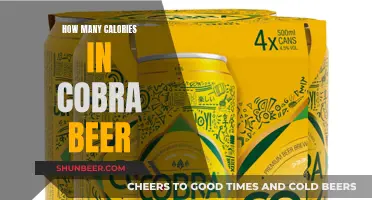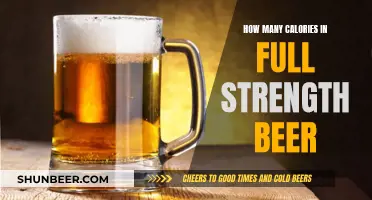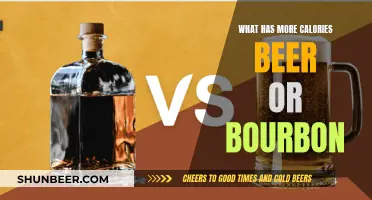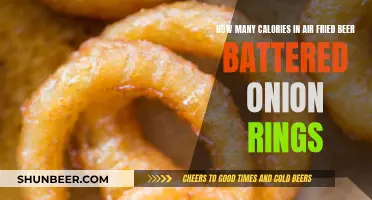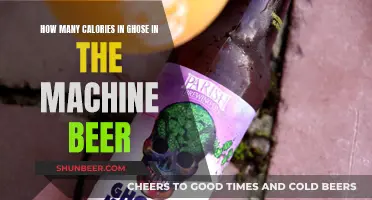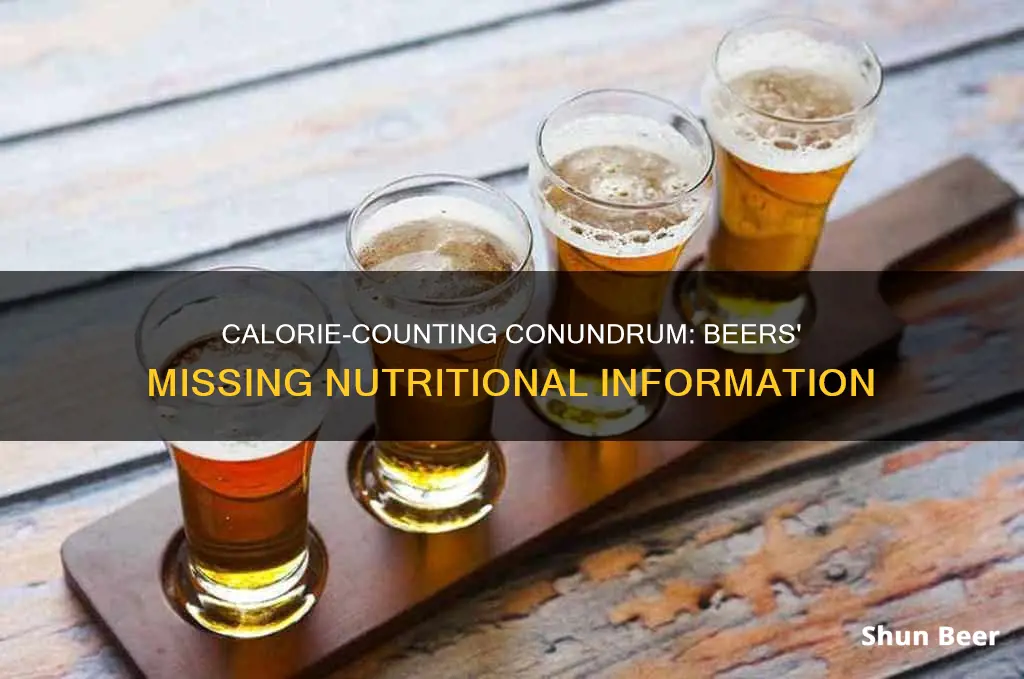
Alcoholic beverages, including beer, are exempt from listing nutritional information due to a historical tradition. After the repeal of Prohibition, the Alcohol Administration Act of 1935 established the Alcohol and Tobacco Tax and Trade Bureau (TTB) to regulate alcohol. Unlike the Food and Drug Administration (FDA), the TTB does not require nutritional labelling, including calorie counts, on alcoholic products. While consumer advocates have pushed for labelling, alcohol manufacturers have resisted, and the TTB has only made nutrition labels optional. This lack of transparency can be problematic as alcoholic drinks are calorie-dense, with a significant proportion of drinkers' total calories derived from alcohol.
| Characteristics | Values |
|---|---|
| Regulatory body | Alcohol and Tobacco Tax and Trade Bureau (TTB) |
| Reasons for exemption | Alcohol isn't classified as a food by the FDA; tradition |
| Calorie count | A pint of IPA contains about 250 calories; a glass of red wine has about 125; a shot of liquor has about 100 |
| Consumer advocacy groups | Center for Science in the Public Interest |
| Manufacturers | Anheuser-Busch, MillerCoors, HeinekenUSA, Constellation Brands Beer Division, North American Breweries, and Craft Brew Alliance |
| Nutrition labels | Made optional in 2013 |
What You'll Learn
- Beers are not classified as food by the FDA
- Alcoholic beverages are regulated by the Alcohol and Tobacco Tax and Trade Bureau (TTB)
- Beers are exempt from disclosing ingredients and nutritional facts
- Beers don't need to list serving facts on their packaging
- Calorie counts are optional for alcoholic beverages

Beers are not classified as food by the FDA
The FDA's modern nutrition labelling requirements, which came into force in 1994, do not apply to alcohol because it is not classified as a food product. Alcoholic beverages are therefore not subject to the same labelling provisions as food products. The TTB has never required nutrition labels on alcoholic drinks, and consumer advocates' multiple attempts to change this have been thwarted by alcohol manufacturers.
In 2013, the TTB made nutrition labels optional for alcoholic drinks, but not mandatory. This has led to some alcohol brands using nutrition as a marketing tool, without a consistent means of comparison between products. For example, beer commercials may advertise their products as low in carbs, but without mandatory labelling, it is difficult to verify these claims.
Some items are required to be listed on alcohol labels, such as substances that may cause sensitivities, including sulfites and synthetic dyes. Additionally, distilled spirits and wines with 7% alcohol or higher must include an alcohol percentage on the label. However, ingredient labelling on alcoholic beverages is entirely optional, which can make it difficult for consumers to know exactly what they are drinking.
The debate around nutrition labels on alcoholic drinks continues, with arguments both for and against. Some argue that consumers are entitled to this information, especially as alcohol can contribute a significant number of calories to one's diet. Others argue that creating a Nutrition Facts label for each variation of an alcoholic product is expensive and time-consuming, particularly for small-scale manufacturers, winemakers, and brewers.
Porter Beer Calories: Everything You Need to Know
You may want to see also

Alcoholic beverages are regulated by the Alcohol and Tobacco Tax and Trade Bureau (TTB)
TTB's labelling requirements for alcoholic beverages include:
- Mandatory listing of substances that may cause sensitivities, such as sulfites and synthetic dyes.
- Mandatory inclusion of alcohol percentage for distilled spirits and wines with 7% alcohol or higher.
- Optional inclusion of calories, carbohydrates, protein, and fat content.
TTB's labelling regulations do not require nutritional information on alcoholic beverages, but manufacturers can choose to include it. TTB's role also includes reviewing labels for compliance with regulations and preventing consumer deception.
Calories in Six Beers: What's the Count?
You may want to see also

Beers are exempt from disclosing ingredients and nutritional facts
Beers are not classified as food by the FDA and are therefore exempt from disclosing ingredients and nutritional facts. Alcoholic beverages, including beer, are regulated by the Alcohol and Tobacco Tax and Trade Bureau (TTB), which has fewer and less stringent labelling requirements. This separation of regulatory organisations dates back to the 1930s when, after Prohibition was repealed, the government established an entity to oversee the regulation of the newly legal beverages.
The TTB has never required nutrition labels, and alcoholic drinks have been able to avoid the requirements that the FDA places on food and non-alcoholic drinks. In 2013, the TTB made labels optional for manufacturers, but not mandatory. This has led to some alcohol brands using nutrition as a marketing tool, without any consistent means of comparison between products.
There are some things that must be labelled on alcoholic drinks, such as substances that may cause sensitivities, including sulfites and synthetic dyes. Distilled spirits and wines with 7% alcohol or higher must include an alcohol percentage. However, listing ingredients such as barley or grapes is completely optional.
Consumer advocacy groups have long argued that alcohol labels should include comprehensive information, but manufacturers have defended the more hands-off approach to ingredient labelling and nutrition facts. Alcoholic drinks are also exempt from disclosing nutritional information due to tradition.
Calories in Jai Alai Beer: A Nutritional Breakdown
You may want to see also

Beers don't need to list serving facts on their packaging
Beers and other alcoholic beverages are not required to list serving facts on their packaging because they are not regulated by the U.S. Food and Drug Administration (FDA). Instead, they fall under the purview of the Alcohol and Tobacco Tax and Trade Bureau (TTB), which does not require nutritional labelling. This separation of regulatory organisations dates back to the 1930s, when, after Prohibition was repealed, the government established an entity to oversee the regulation of newly legalised beverages. This entity evolved into the TTB, and its regulatory responsibilities have always been separate from the FDA.
The TTB has never required nutrition labels like those mandated by the FDA. In 2013, the TTB made labels optional for alcohol manufacturers, but not mandatory. This has led some alcohol brands to use nutrition as a marketing strategy, without a consistent means of comparison between products. For example, beer commercials might tout the absence of high-fructose corn syrup or the low number of carbs in their products.
There have been several attempts to change this status quo. In 1993, the TTB solicited comments from the public and industry on whether their regulations should be amended to require nutrition facts on labels. However, only seven consumers responded, most of whom opposed nutrition labelling. In 2003, consumer advocacy groups such as the Center for Science in the Public Interest lobbied the TTB to require nutrition labels. In response, manufacturers asked for voluntary labels, arguing that putting nutrition facts on bottles would make consumers think that alcohol was nutritious. In 2004, the TTB sided with manufacturers, issuing guidelines that allowed them to list calories, carbs, protein, and fat if they wanted. Only light beers advertised as "low carb" were required to show this information.
In recent years, some beer manufacturers have voluntarily included serving facts on their packaging. In 2019, Bud Light became the first American beer to do so, listing its ingredients as well as calories, fat, carbohydrates, and protein per serving. Other brands under AB InBev, such as MillerCoors, Heineken USA, and more, have also followed suit. These companies may view this as a selling point for calorie-conscious consumers. However, for small-scale manufacturers, winemakers, and brewers, requiring labels would raise production costs.
Calories in Founders All Day IPA: Beer Breakdown
You may want to see also

Calorie counts are optional for alcoholic beverages
Alcoholic drinks are a significant contributor to our daily calorie intake. A 2012 study found that the average American adult consumes 100 calories a day from alcoholic beverages. However, calorie counts are not always listed on these drinks. This is because alcoholic beverages are not regulated by the FDA but by the Alcohol and Tobacco Tax and Trade Bureau (TTB), which does not require nutritional labelling.
In 2013, the TTB made nutrition labels optional for alcoholic beverages, but not mandatory. This means that alcohol manufacturers can choose whether or not to include nutritional information on their products. As a result, most alcoholic drinks do not have nutrition labels, and consumers are often unaware of the calorie content of the drinks they are consuming.
There have been several attempts to change this status quo and require alcoholic beverages to have nutrition labels. In 1993, the TTB solicited comments from the public and industry on whether their regulations should be amended to include nutrition facts on labels. However, the response was minimal, with only seven consumers offering their opinions, most of whom opposed nutrition labelling. In 2003, consumer advocate groups lobbied the TTB to require nutrition labels, but manufacturers asked for voluntary labels, arguing that putting nutrition facts on bottles would make consumers think that alcohol was nutritious.
The debate over whether to include nutritional information on alcoholic beverages continues. There are pros and cons to adding nutrition labels. On the one hand, it could help people become more aware of serving sizes and how alcohol contributes to their daily calorie intake. It could also provide peace of mind to know what ingredients are in the drinks they are consuming. On the other hand, creating a Nutrition Facts label for each variation of each product is expensive and time-consuming, especially for vintage wine and special craft beer. Additionally, some argue that including a nutrition label on alcohol could make it seem more like a food than a drug.
For now, the decision to include nutritional information on alcoholic beverages is left to the manufacturers. Some alcohol companies have started to include serving facts statements on their labels, citing a commitment to "quality and transparency." However, many alcoholic drinks still do not include nutritional information, leaving consumers to guess how many calories they are consuming.
Best Low-Calorie Brews: Light but Mighty Beers
You may want to see also
Frequently asked questions
Beers don't list calories because they are not required to by law. Alcoholic beverages are regulated by the Alcohol and Tobacco Tax and Trade Bureau (TTB), which does not require nutritional labelling.
The Alcohol and Tobacco Tax and Trade Bureau (TTB) is a federal agency that regulates alcoholic beverages in the United States. The TTB was established after the repeal of Prohibition to generate tax revenue from newly-legalised alcohol.
Yes, consumer advocates have pushed for nutritional labelling on alcoholic beverages several times. In 2013, the TTB made nutrition labels optional for alcoholic beverages, but some health experts believe this move did not go far enough.


